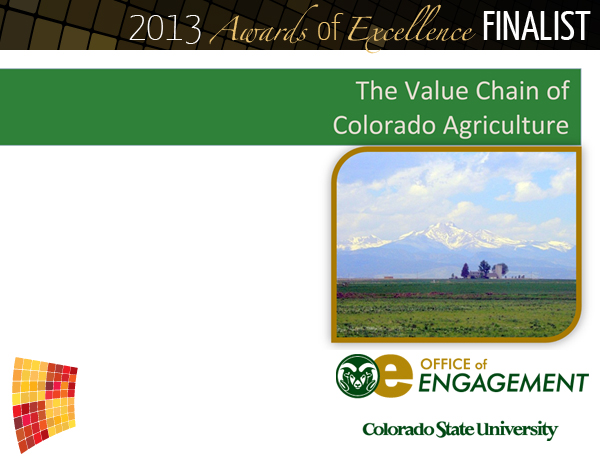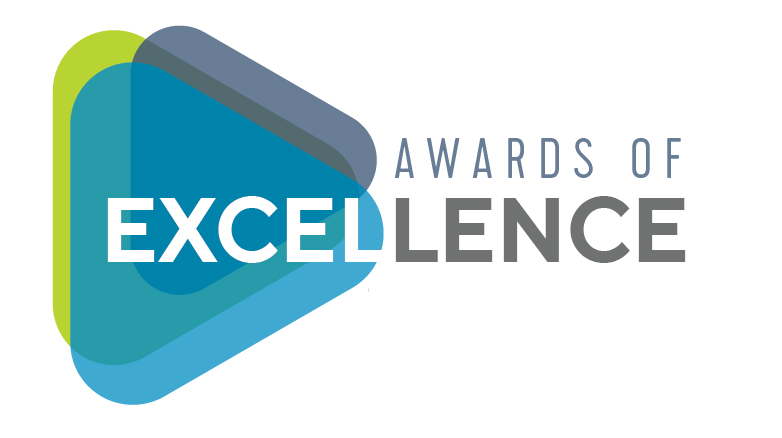Network

| Award Category: | Research and Analysis |
| Project Site: | The Value-Chain of Colorado Agriculture |
| Submitted By: | Colorado State University |
| Contact: | Geniphyr Ponce-Pore, 970.491.6148 |
Case Study
Abstract
In June 2012, Colorado’s Governor Hickenlooper remarked that “Agriculture led the Colorado out of the recession,” highlighting Colorado’s agriculture as a critical driver of Colorado’s economy. The typical research methodology employed by business schools to better understand industry barriers and opportunities is a supply chain analysis. Already knowing the linear progression of goods through the stages of agricultural production, we needed an innovative research and analysis methodology to reveal industry dynamics, characterize the unexpected connections within the industry, and gain a more holistic perspective of how this industry operates more as a web than a progression. To accomplish this we worked with our College of Agriculture, and Agriculture Economics faculty to develop the Value Chain of Colorado Agriculture. This value chain research and analysis, which has never been done before for the full agriculture industry in Colorado, revealed new unexpected collaborations, new potential research opportunities, a fresh perspective on agriculture from non- agriculture industries, and a broader set of agriculture industry connections.
The Value Chain encompassed more diversity than is typical, including 125 separate sub-sectors. This study focused on workforce, agricultural innovation and technologies, building or recruiting agriculture businesses, and identifying the unique branding opportunities in Colorado to reach the global audience and their markets. As a result of the study, government, industry, workforce, and economic development strategies can better leverage existing strengths. This innovative research and analysis creates opportunities for broader, integrated decision making which accelerates the advance of Colorado agriculture in a global economy.
Problem/Background
In 2011, Colorado State University’s (CSU) Office of Community and Economic Development began working with the Colorado Office of Economic Development and International Trade (COEDIT), the Colorado Department of Agriculture (CDA), and Governor John Hickenlooper to further the community-led economic development strategic planning process known as the Colorado Blueprint Initiative.
As a result of this community input, the Colorado Blueprint Initiative identified 14 Key Industry Networks (KINs) within Colorado driving local, regional and state economies. As a direct result of CSU’s involvement, Food and Agriculture was identified as one of those 14 KINs. Given CSU’s land-grant history and past engagement with State economic development initiatives, CSU and Office for Community and Economic Development were chosen to recruit, convene, and facilitate food and agriculture industry leaders from around Colorado. Colorado State University, along with Colorado Office of Economic Development and International Trade and Colorado Department of Agriculture (CDA), convened a Steering Committee and a larger tactical team in May of 2012 with the task of defining an economic strategy and action plans to execute those strategies, respectively. By the end of May a draft Mission, Vision, SWOT Analysis and Implementation Plan were prepared based on six core economic development objectives:
• Build a business-friendly regulatory environment
• Recruit, grow, and retain companies
• Improve access to capital
• Create and market a stronger “Colorado” brand
• Educate and train the workforce of the future
• Cultivate innovation and new technologies.
However, subsequent review of the draft by the KIN steering committee highlighted two critical issues: 1) the absence of a cohesive industry identity and understanding, and 2) a lack of relevant, updated economic information needed to further the conversation.
Solution
In response to the critical issues defined by the KIN steering committee, CSU convened leading experts with the challenge of redefining agriculture to include everything from “dairy to biotech” and characterizing the innovative opportunities emerging in this new way of looking at a traditional industry. After numerous meetings with professors in agriculture, natural resources, economics, and other disciplines, a new methodology was developed to gain the insight needed for a cohesive and holistic perspective on Colorado Agriculture. The research initiative was named the Value Chain of Colorado Agriculture.
Most conventional industry-level economic analyses utilize supply chain analysis techniques instead of value-chain approach. However, in industries like agriculture a supply-chain approach is often overly linear and reductive and leads to conversations that reinforce commodity silos rather than invigorate a systematic and industry wide discourse on collective impact, needs and opportunities. Moreover, supply chain analyses do not adequately reflect the complex, interconnected realities of agriculture in Colorado. Thus, an agricultural value chain was necessary to adequately address these complexities.
The Value Chain of Colorado Agriculture was uniquely defined as the flow of inputs and outputs that enable agricultural enterprises at the core of the value chain to realize the value of their unique capital base through sales, ultimately, of retail products to final consumers. For practical purposes, we have identified the core of the agricultural value chain to be that set of enterprises counted as farm and ranch operations in the 2007 USDA Census of Agriculture. We then followed the value chain from inputs, through to outputs, including livestock, crops, and off-farm income, on to manufacturing and marketing, and ultimately down to revenue generated by Colorado retailers. The final analysis included 125 separate sub-sectors each with an economic link to farm or ranch operations. This comprehensive approach allowed us to analyze a fuller and more diverse picture of the economic impacts of agriculture from the linkages that turn raw materials and other inputs into final products to the workforce contributions and ecological services provided by development easements.
The Value-Chain of Colorado Agriculture also evaluated technological innovation, from data systems to genetics, along the value chain to locate key clusters of innovation throughout the state, as reflected by patents. These innovation maps provided an additional point of information to decision makers and broadened the public’s perception of agriculture as a key driver of innovation.
Lastly, the final report of the Value-Chain of Colorado Agriculture was framed in part with the six core economic development objectives of the Colorado Blueprint Initiative. This framing furthered focused the value-chain analysis on workforce, agricultural innovation and technologies, building or recruiting agriculture businesses, and identifying the unique branding opportunities in Colorado to reach the global audience and their markets. As a result of this research and analysis, CSU and OEDIT were able to convene new conversations with government, industry, workforce, and economic development experts focused around the unique economic contributions and innovations of agriculture in Colorado. These conversations were now centered around relevant, updated economic information about agriculture and helped to foster a cohesive industry identity and understanding, thus addressing the critical issues identified by the KIN steering committee.
Results
The Value-Chain of Colorado Agriculture has provided economic, community, and workforce developers, as well as industry leaders and state and local governments with a new and shared understanding of one of Colorado’s key economic drivers. This report of Colorado’s agriculture industry expanded the traditional view of agriculture by including the diverse but interconnected 125+ subsectors that make up this critical industry. Although traditional agriculture continues to thrive, this report revealed emerging and interconnected sub-sectors within the overall agriculture industry, expanding the reality of what is “agriculture” in Colorado. Through this iterative methodology, and the lens of the Governor’s Six Core Objectives for Colorado’s economy, the report showed how agriculture in the state creates jobs, drives business, and supports communities across the state. (Governor Hickenlooper’s Six Core Objectives for Colorado’s economy are: 1. Build a business-friendly environment; 2. Retain, grow and recruit companies; 3. Increase access to capital; 4. Create and market a stronger Colorado brand; 5. Educate and train the work force of the future; 6. Cultivate innovation and technology). The report also created an avenue for the industry to speak into our research, and helped to inform the methodology.
When complete, we took the report on the road, sharing the results with economic developers, policy makers, state and local governments, industry experts, and community champions across Colorado. Through these conversations, we helped Coloradoan’s connect to the research and created a way for them to share their stories with us and each other. The report and the presentations created a bridge between traditional and emerging subsectors in the industry and helped Coloradoans see its innovative and entrepreneurial spirit. The report, as well as the many conversations that have occurred as a result of this work, have shifted the perspective of those both within and outside the industry. This has created an opportunity for a shared conversation about how to build on emerging opportunities across the value chain. The Colorado Office of Economic Development and International Trade was successful in using this expanded perspective in attracting the headquarters of an international ag company to Colorado, resulting in an anticipated 250 primary jobs.
This research and analysis is helping to shift how businesses, policy makers, rural communities, and those who have never lived or worked on the land see this industry in a new way. The awareness of shared challenges and opportunities across the value chain has created a way to reach across the value chain to find a new partner on policy development, create new business opportunities, identify shared workforce training needs and address other issues. It also provides insight for economic developers and policy makers to understand a complex and sometimes hard to understand industry. For the university, the Value chain provided a new methodology for the university to better understanding industry, and engage with us cooperatively in our research. This cross-pollination serves to make the whole industry more resilient and more creative, and helps our land-grant university fulfill its mission to engage Coloradoans and support our economy and communities.
Future Considerations
While initial support for the Value-Chain of Colorado Agriculture was provided by CSU and CDA, the team at CSU’s Office of Community and Economic Development continues to work with CDA and industry partners to identify the next steps in research that will build from this foundation. The Value Chain of Colorado agriculture has already generated great industry and state interest, and has stimulated funding for follow up research studies on agricultural industry mapping, agricultural innovation analysis, intergenerational transfer of agricultural wealth, and a culture of increased collaboration within the university.
The Value-Chain of Colorado Agriculture methodology has been defined and reviewed by experts within the university. It has also been used by economic, community and workforce developers to gain insight into a dynamic and changing industry. It has been used to look at the state as a whole, as well as more local and regional insights. Because of the chosen data sets, it is easily scalable both up to multi-state analysis as well as down to regional or commodity cluster analysis. While the easiest applications would utilize our existing definition of the Food and Agriculture industry network, the value chain approach could also be applied to both broader definitions of agriculture or narrow in a specific subsectors.. The value-chain research and analysis is also replicable in other industries or other states. In fact, Colorado is already anticipating a Value Chain 2.0 which would update the numbers of our initial analysis and begin to track trends in industry dynamics.
Finalist Presentation
UEDA Awards of Excellence Finalists presented at the Annual Summit in Pittsburgh on October 28, 2013. Summit attendees then voted for the best initiative in each category.

